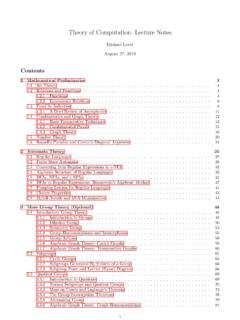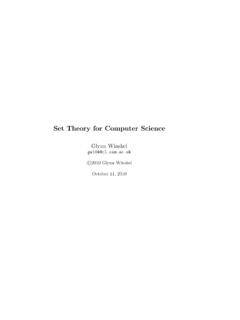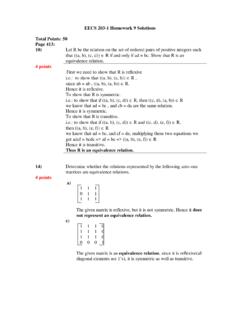Transcription of Cosets, Lagrange’s theorem and normal subgroups
1 Cosets, Lagrange s theorem and normal subgroups1 CosetsOur goal will be to generalize the construction of the groupZ/nZ. Theidea there was to start with the groupZand the subgroupnZ= n , wheren N, and to construct a setZ/nZwhich then turned out to be a group(under addition) as well. (There are two binary operations + and onZ, butZis just a group under addition. Thus, the fact that we can alsodefine multiplication onZ/nZwill not play a role here, but its naturalgeneralization is very important in Modern Algebra II.) We would like togeneralize the above constructions, beginning with congruence modn, tothe case of a general groupG(written multiplicatively) together with asubgroupHofG.
2 However, we will have to be very careful ifGis a group and letH G. We define a relation `(modH) onGas follows: ifg1,g2 G, theng1 `g2(modH) ifg 11g2 H, or equivalently if there exists anh Hsuch thatg 11g2=h, ifg2=g1hfor someh relation `(modH)is an equivalence equivalence class containinggis the setgH={gh:h H}. allg G,g 1g= 1 H. Henceg `g(modH) and `(modH) is reflexive. Ifg1 `g2(modH), theng 11g2 H. But sincethe inverse of an element ofHis also inH, (g 11g2) 1=g 12(g 11) 1=g 12g1 H. Thusg2 `g1(modH) and hence `(modH) is , ifg1 `g2(modH) andg2 `g3(modH), theng 11g2 Handg 12g3 H.
3 SinceHis closed under taking products,g 11g2g 12g3=g 11g3 H. Henceg1 `g3(modH) so that `(modH) is transitive. Thus `(modH) is an equivalence relation. (Notice how we exactly used thedefining properties of a subgroup.) Clearly, the equivalence class containinggis the setgHdefined setgHdefined above is theleft cosetofHcontainingg. By general properties of equivalence classes,g gHand two left cosetsg1 Handg2 Hare either disjoint or equal. Note that the subgroupHis itselfa coset, sinceH= 1 H=hHfor everyh H. It is called theidentitycoset. The set of all left cosets, the set of all equivalence classes for theequivalence relation `(modH), is cosetsHg={hg:h H}are similarly defined.
4 They are equiva - lence relations for the equivalence relation r(modH) defined by:g1 rg2(modH) ifg2g 11 H, or equivalently if there exists anh Hsuch thatg2g 11=h, ifg2=hg1for someh H. The set of all equivalence classesfor the equivalence relation r(modH), is denotedH\G. However, wewill sometimes just use coset to mean left coset and use right coset for emphasis. Of course, ifGis abelian, there is no difference between leftcosets and right cosets. (There is also a somewhat non-obvious bijectionfrom the setG/Hto the setH\G; this is a homework problem. However,as we shall see below, in general the setsG/HandH\Gare different.)
5 Example ForG=Z(under addition) andH= n =nZ, wheren N, we recoverZ/nZ. Here the cosets are the subsets ofZof theform 0 + n = [0]n, .. , (n 1) + n = [n 1] For anyG, withH=G, for allg1,g2 G,g1 `g2(modG), thereis just one left cosetgG=Gfor allg G, andG/Gis the singleelement set{G}. Similarly there is just one right cosetG=Ggforeveryg G; in particular, the set of right cosets is the same as the setof left cosets. For the trivial subgroup{1},g1 `g2(mod{1}) g1=g2, and the left cosets of{1}are of the formg{1}={g}. ThusG/{1}={{g}:g G}, the set of 1-element subsets ofG, and hencethere is an obvious bijection fromG/{1}toG.
6 As{1}g={g}, everyright coset is again a left coset and In the groupS3, taking forHthe subgroupA3= (1,2,3) ={1,(1,2,3),(1,3,2)},there are two left cosets:A3and (1,2)A3={(1,2),(1,3),(2,3)}. It iseasy to see that these two sets are also the right cosets Again withG=S3, if instead ofA3we take forHthe 2-element sub-group (1,2) ={1,(1,2)}, then there are three left cosets:{1,(1,2)},{(1,2,3),(1,3)}, and{(1,3,2),(2,3)}, each with two elements. ThusS3is divided up into three disjoint subsets. We can also consider the2right cosets for{1,(1,2)}. There are three right cosets:{1,(1,2)},{(1,2,3),(2,3)}, and{(1,3,2),(1,3)}.
7 In particular, we see that theright cosets are not in general equal to the left To generalize the first part of (3) above, considerG=SnandH= discussion onAnshowed that, if is any odd permutation, thenthe coset Anis the subset of odd permutations ofSn. Hence thereare exactly two left cosets ofAninSn, the identity cosetAnwhich isthe subset of even permutations and the set An, where is any oddpermutation, which is the same as the set of odd permutations andhence equalsSn An. It is easy to see thatSn An=An for everyodd permutation , and hence the right cosets are the same as the leftcosets in this general, we would like to count how many elements there are in a leftcoset as well as how many left cosets there a group,Ha subgroup, andg G.
8 The functionf(h) =ghdefines a bijection fromHtogH. Hence, ifg1 Handg2 Haretwo cosets, there is a bijection fromg1 Htog2H. Finally, ifHis finite, thenevery left cosetgHis finite, and#(gH) = #(H). in the statement, clearlyfis surjective by definition,andfis injective by cancellation, sincegh1=gh2= h1=h2. Thusfisa bijection. The remaining statements are a group and letHbe a subgroup ofG. If the setG/His finite, then we sayHis of finite index inGand call the number ofelements #(G/H) theindexofGinH. We denote #(G/H) by (G:H). IfG/His infinite, then we sayHis of infinite index , forn N, the index (Z:nZ) isn, even though bothZandnZare infinite.
9 On the other hand,{0}is of infinite index inZ. Clearly, ifGis finite, then every subgroupHhas finite index. Every element ofGis inexactly one left cosetgH. There are (G:H) left cosetsgH, and each onehas exactly #(H) elements. Adding up all of the elements in all of the leftcosets must give the number of elements ofG. Hence:Proposition a finite group and letHbe a subgroup #(G) = (G:H)#(H). In other words, the index(G:H)satisfies:(G:H) = #(G)/#(H).3 This very simple counting argument has a large number of significantcorollaries:Corollary (Lagrange s theorem ).LetGbe a finite group and letHbea subgroup ofG.
10 Then#(H)divides#(G).Remark have already seen that Lagrange s theorem holds for acyclic groupG, and in fact, ifGis cyclic of ordern, then for each divisordofnthere exists a subgroupHofGof ordern, in fact exactly one converse to Lagrange s theorem is howeverfalsefor a general finitegroup, in the sense that there exist finite groupsGand divisorsdof #(G)such that there is no subgroupHofGof orderd. The smallest example isthe groupA4, of order 12. One can show that there is no subgroup ofA4of order 6 (although it does have subgroups of orders 1,2,3,4,12). Also, agroup that is noncyclic can have more than one subgroup of a given example, the Klein 4-group (Z/2Z) (Z/2Z) has three subgroups oforder 2, as a finite group and letg G.








![[Ch 8] Relations 1. Basics - DePaul University](/cache/no-preview.jpg)





